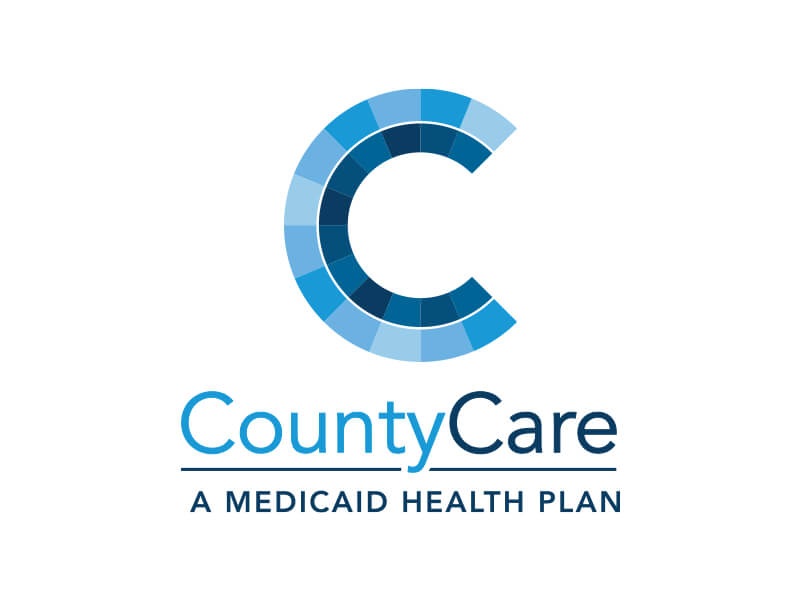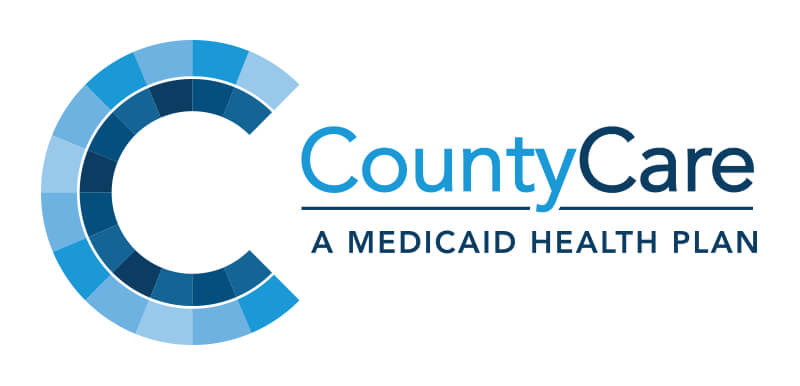Redetermination News, Open Enrollment, HEDIS® Measure Audit MY2023, Access and Availability Requirements, Universal IAMHP Roster Training, Flu Season is Here, CountyCare and A Safe Haven, Contact your Provider Relations (PR) Representatives
Provider Newsletters

Spring 2023 Newsletter
Redetermination News, Universal IAMHP Roster Training, CountyCare’s Cultural Competency Training, Access to Care Reminder, Prior Authorization Updates, Opioid & Benzodiazepine Prescribing Updates, 2023 Pay-for Performance Program, Introducing Foodsmart, Partner Updates

October 2022 Newsletter
Thankful for a Decade of Providing Care, Expanded Urgent Care Network, Redetermination is Coming–Help Us Get Ready!, Provider Information Available on the Website, PCP Roster for OB/GYNs and Pediatrics, Monitoring Opioid Use, Flu Season is Upon Us , DocAssist, Timely Provider Rosters=Timely Claim Payments
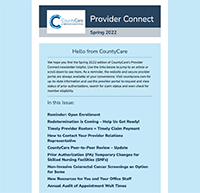
April 2022 Newsletter
Open Enrollment, Redetermination is Coming, Timely Provider Rosters = Timely Claim Payment, How to Contact Your Provider Relations Representative, CountyCare Peer-to-Peer Review Update, PA Temporary Changes for Skilled Nursing Facilities, Non-Invasive Colorectal Cancer Screenings, New Resources for You and Your Office Staff, Annual Audit of Appointment Wait Times
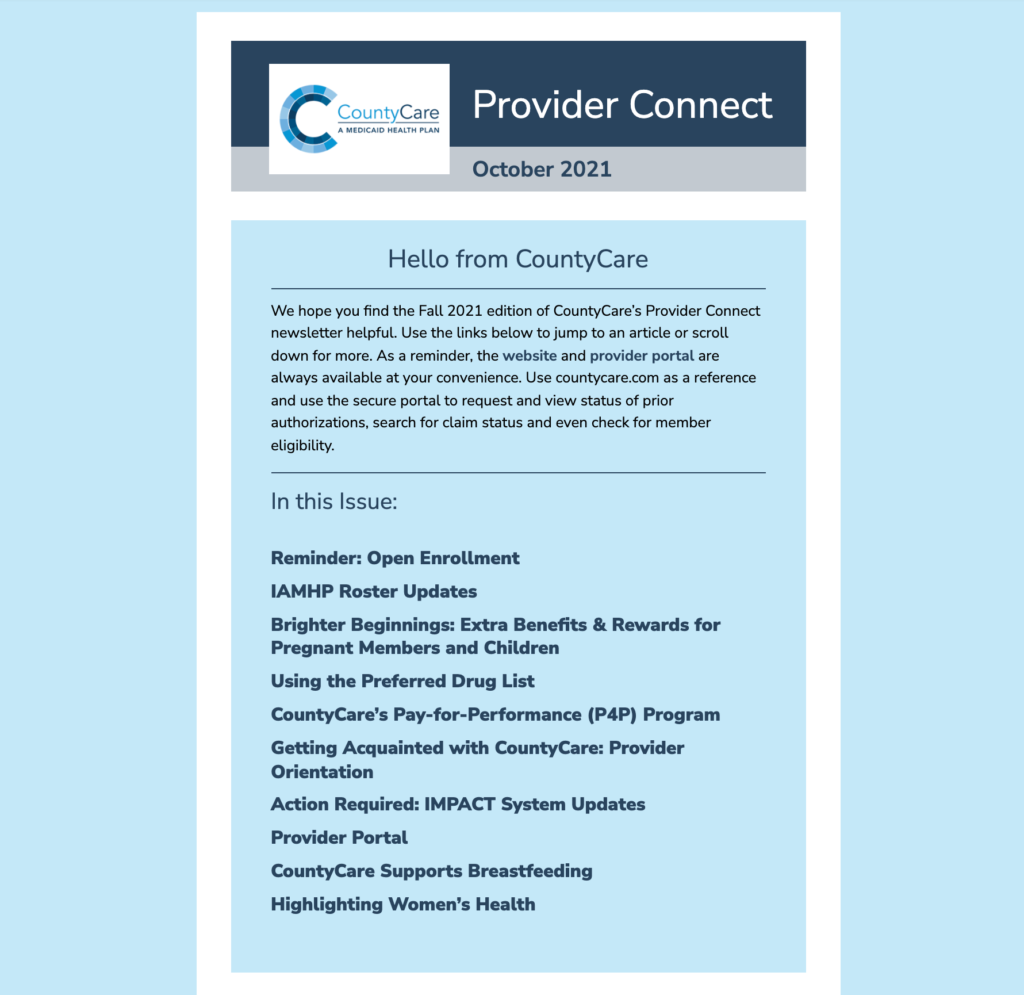
Fall 2021 Newsletter
Open Enrollment, IAMHP Roster Updates, Brighter Beginnings: Extra Benefits & Rewards for Pregnant Women and Children, Using the Preferred Drug List, CountyCare’s Pay-for-Performance (P4P) Program, Getting Acquainted with CountyCare Provider Orientation, Action Required: IMPACT System Updates, Provider Portal, CountyCare Supports Breastfeeding, Highlighting Women’s Health
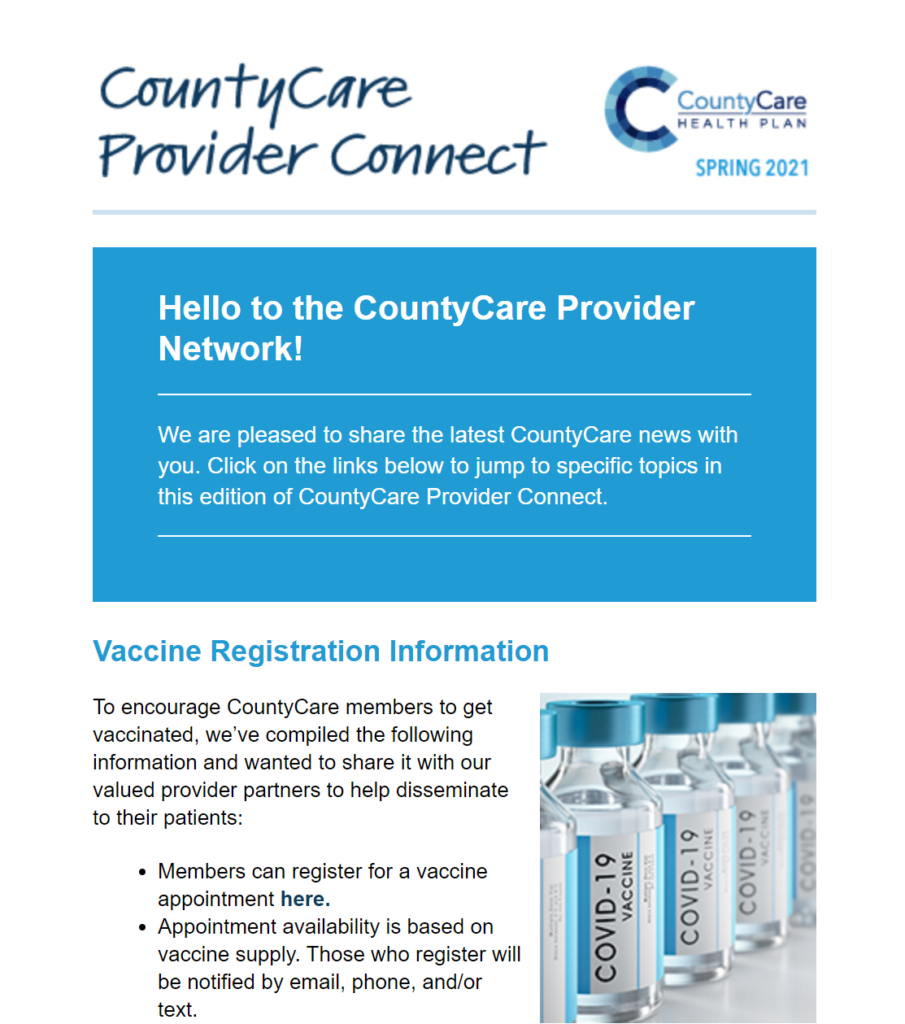
Spring 2021 Newsletter
COVID-19 Vaccine Registration Information, Billing Update Related to COVID-19 Vaccines, Non-Emergent Medical Transportation Ambulance Claims Update, Support Act: New Updates for Opioids, CountyCare’s Commitment to Provider Diversity, Equity and Inclusion, CountyCare.com Makeover, and Updates from the CountyCare Quality Team.
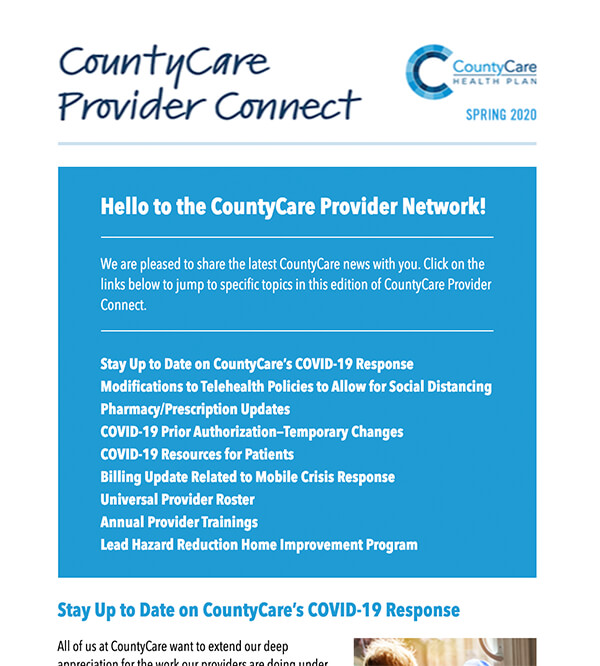
Spring 2020 Newsletter
CountyCare’s COVID-19 Response, Telehealth Policies to Allow for Social Distancing, Pharmacy/Prescription Updates, COVID-19 Prior Authorization—Temporary Changes, COVID-19 Resources for Patients, Billing Update Related to Mobile Crisis Response, Universal Provider Roster, Annual Provider Trainings, Lead Hazard Reduction Home Improvement Program.

Winter 2020 Newsletter
Open Enrollment, New CMS Regulation, Prescribing (ORP) Providers, Save Time on the Provider Portal, Helping Patients with REDE, New Dental & Vision Partner, Balance Billing, Pay for Performance, Provider Roster, Provider Annual Notice
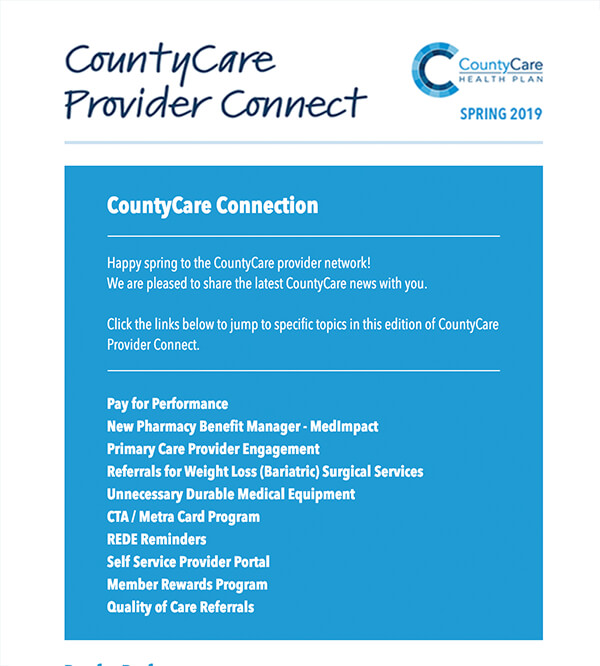
Spring 2019 Newsletter
Pay for Performance, New Pharmacy Benefit Manager – MedImpact, Primary Care Provider Engagement, Referrals for Weight Loss (Bariatric) Surgical Services, Unnecessary Durable Medical Equipment, CTA / Metra Card Program, REDE Reminders, Self Service Provider Portal, Member Rewards Program, Quality of Care Referrals.
Winter 2018 Newsletter
Members Transition to CountyCare, HEDIS Helps in Curbing Childhood Obesity Role, STDs – What You Need to Know Now, Medicaid Homes Recognized, ICAAP Events.
CountyCare is pleased to announce that Family Health Network (FHN) and Aetna Better Health Medicaid members have transitioned to CountyCare, creating the largest Medicaid plan in Cook County. CountyCare, FHN and Aetna have a long history of caring for the Medicaid population in Illinois. This exciting growth expands CountyCare’ss strong commitment to providing a strong network and the resources of a large health plan to serve the residents of Cook County.
Our goal is to maintain patient-care continuity through strong provider relationships.
What does this mean for you as a provider?
- If you are a current CountyCare provider, you will maintain your existing panel of FHN, Aetna Better Health and CountyCare patients.. Please use all appropriate billing and prior authorization processes.
- If you are a current FHN or Aetna provider without a CountyCare contract, CountyCare will accept existing FHN and Aetna contracts until providers can be transitioned to new CountyCare contracts. We have developed a customized webpage with additional information and answers to frequently asked questions regarding the transition.
- Please remember to submit claims to the appropriate health plans for dates of service prior to members being effective with CountyCare.
- Starting with services provided on November 1, 2017 for FHN and January 1, 2018 for Aetna Better Health, submit claims to CountyCare. Our Clearinghouse Vendor is Change Healthcare (formerly known as Emdeon). CountyCare’s Payor ID is: 06541. Please update your systems to ensure appropriate and timely claims payment. Additional information regarding CountyCare’s Provider billing resources are located at https://www.countycare.com/providers/provider-billing-resources
What does this mean for your patients who are transitioning to CountyCare?
- All members will still have all the same benefits and rights under CountyCare. In addition CountyCare has enhanced its add-on benefits and incentives.
- Former FHN members received their new CountyCare identification cards in early November. Former Aetna Better Health members will receive their new CountyCare identification cards in January.
Your partnership in the coming months will be greatly appreciated as we complete this complex transition. Please know that as always, our top priority is patient care. Should you have questions or concerns, please check our website or call Provider Relations at 312-864-8200.
Your role on the front line of patient care can have a substantial impact on reducing childhood obesity.
Childhood obesity is widely recognized as a preventable epidemic that has serious impact on both the current health and long-term health of our children and adolescents. The Weight Assessment and Counseling for Nutrition and Physical Activity for Children and Adolescents (WCC) HEDIS measure was designed to help address this issue and also ensures you are meeting all requirements to monitor child weight among your patients to be eligible for reimbursement.
The WCC measure calls for the most critical components of assessing risk for childhood obesity, including body mass index (BMI), counseling for physical activity and nutritional counseling. Accordingly, both HFS and CountyCare have made WCC a Priority Quality Measure. CountyCare has not yet achieved our target for this critical HEDIS measure and we need your assistance in improving performance. We know that talking to parents about weight issues in their children can sometimes be difficult or awkward, but children’s healthcare providers are in the best position to do this.
Links to Help You Guide Kids to Healthy Lifestyles
- Perform certain care and screenings at least annually for all patients ages three to 17.
- The American Academy of Pediatrics (AAP) offers an app and other simulation resources that help you guide conversations with parents about children who are overweight.
Consistently following WCC requirements ensures that you will be reimbursed for following WCC guidelines – and most important, offers a bright outlook for the health of your young patients.
In part one of this two-part series, we informed clinicians of the increased number of Sexually Transmitted Diseases (STDs) that are being seen in Illinois and nationwide. The Illinois Department of Public Health (IDPH) STD Section has finalized the 2016 STD surveillance data for chlamydia, gonorrhea and syphilis. For the third year in a row, Illinois has seen an increase in each of these three reportable STDs. In this series, we focus on chlamydia since chlamydia is the most common notifiable disease reported in the U.S. and chlamydia screening in females 16-24 years of age is a HEDIS measure (CHL).
STD Screening in Men
Chlamydia screening measures target women since women are more severely and disproportionately impacted by chlamydia’s complications. The Centers for Disease Control and Prevention (CDC) recommends annual screening for chlamydia in all sexually active women under 25 years of age, whereas they recommend “considering” screening young heterosexual men only in high prevalence clinic settings or in populations with a high burden of infection, such as communities within Cook County.
For men who have sex with other men (MSM), the CDC recommends chlamydia/gonorrhea screening at least annually, which includes testing from all site(s) of sexual contact (urethra, rectum, pharynx) regardless of condom use. According to a 2011 study published in Sexually Transmitted Disease, 83.3% of chlamydial and gonococcal infections among asymptomatic MSM visiting an urban municipal sexually transmitted disease clinic would have been missed by urethral screening alone. More intensive screening is recommended for MSM since this groups is disproportionately impacted by many STDs, including, but not limited to, chlamydia, syphilis and antimicrobial resistant gonorrhea when compared to women and men who have sex with women (MSW). (1)
Providers should always take a complete sexual history and consider screening male patients for STDs (especially MSM) if warranted. Complications of chlamydia and gonorrhea are less common in men than in women, but both males and females can experience sexually acquired reactive arthritis (SARA) or Lymphogranuloma venereal (LGV), which causes a genital ulcer or papule and can result in proctocolitis mimicking inflammatory bowel disease, mucoid and/or hemorrhagic rectal discharge, anal pain, constipation, fever and/or tenesmus. (3)
Pregnant and Preconception Women and STDs
STDs can complicate pregnancies and the ability to become pregnant. Congenital syphilis has been rising in the past few years and can cause congenital infection, low birthweight, prematurity and fetal/neonatal death. Left untreated, STDs such as chlamydia or gonorrhea can seriously damage a woman’s uterus or fallopian tubes causing pelvic inflammatory disease (PID), which may lead to chronic abdominal pain, ectopic pregnancies, and infertility. In addition, pregnant women with untreated chlamydia infection can suffer from miscarriage or pre-term delivery, and can pass the infection to their newborn during delivery, causing ophthalmia neonatorum (conjunctivitis) or pneumonia.
Thus, it is recommended for all pregnant women under 25 years of age to be screened for chlamydia at their first prenatal visit and again during the third trimester. For women ages 25 and older, testing is only recommended if the women are considered at increased risk. If a pregnant woman is found positive for chlamydia, it is imperative to provide treatment immediately and perform a test-of-cure 3-4 weeks after treatment. It is also recommended for the patient to be retested 3 months post-infection for possible re-infection. Additional STDs that pregnant women are either recommended or required by law to be tested for are gonorrhea, syphilis, and HIV.
STDs are among the most preventable risks to pregnancy outcomes for women seeking preconception and prenatal care. Preconception and prenatal care allows for interventions such as STD screening, treatment, and risk behavior interventions. These interventions can favorably impact the woman and her developing fetus, which can improve birth outcomes and allow for healthier mothers to care for their children.
Expedited Partner Therapy (EPT) allows healthcare providers to offer prescription drugs without prior medical evaluation or clinical assessment to the partner or partners of persons diagnosed with chlamydia or gonorrhea (in the last 60 days) who are unable or unlikely to seek care. EPT has been proven safe and effective; adverse reactions to recommended treatment regimens for chlamydia and gonorrhea are rare. In 2010, an EPT law was passed in Illinois protecting clinicians providing EPT from civil and professional liability, except for willful and wanton misconduct. Click here for the Illinois EPT Law.
Monetary Burden of STDs on Healthcare
In 2013, the CDC published two analyses that assessed the severe human and economic burden of the 8 major STDs among youth in the US. In these analyses, the CDC estimated an incidence of 20 million new infections and a prevalence of more than 110 million new and existing infections at a given time among men and women in the United States each year, costing the American healthcare system nearly $16 billion in direct medical costs (in 2010 dollars).
Prevention through screening, diagnosis and prompt treatment is needed in order to combat the ever-growing number of STDs nationwide. The CDC has outlined specific screening recommendations for many STDs that should be followed by all providers. Unfortunately, many, if not most, women are not receiving this cost-effective preventive health service (6). The table below presents the outcomes of chlamydia screening among reported female specimens tested in Illinois laboratories. Based on the following assumptions from recent studies, this data estimates the number of PID and infertility-related morbidity avoided by chlamydia screening and adequate treatment regimens, as well as an estimated yearly healthcare cost savings for averting PID-related interventions on those females testing positive that were screened and adequately treated.
Cases of PID and Infertility Avoided by Chlamydia Screening from Reporting Illinois Laboratories – 2015
The assumptions used for this data analysis include: the risk of PID is 30% among women with untreated or unsuccessfully treated acute infection, 20% of women who experience PID will become infertile and the average cost per case of PID being estimated at $1,955. A chlamydia treatment adequacy rate for all of Illinois is calculated at 78%, which was derived from data submitted in the 2015 Illinois National Electronic Disease Surveillance System (INEDSS).

1 STDs: chlamydia, gonorrhea, syphilis, HIV, HBV, HPV, herpes, & trichomoniasis
Chlamydia Screening Update; Highest HY18 Screen Rate to Receive Award
CountyCare met the target for chlamydia screens for sexually active women ages 16-24 (see below) in the most recent HEDIS results, but screens in other age groups were lacking. While the screening rates improved in all categories, we did not meet our target rates in the other age categories.
You can get recognized and rewarded for improving chlamydia screening rates among your patients. CountyCare will honor the medical home with the highest screening rate in HY18 with our Public Health Provider Recognition Award. Details to follow.
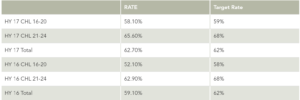
Resources
Centers for Disease Control and Prevention (CDC), (August, 2016). Screening Recommendations and Considerations Referenced in Treatment Guidelines and Original Sources https://www.cdc.gov/std/tg2015/screening-recommendations.htm
Centers for Disease Control and Prevention (CDC), (February 2013). Incidence, Prevalence, and Cost of Sexually Transmitted infections in the United States https://www.cdc.gov/std/stats/sti-estimates-fact-sheet-feb-2013.pdf
Centers for Disease Control and Prevention (CDC), (June, 2015). Lymphogranuloma Venereal (LGV) https://www.cdc.gov/std/tg2015/lgv.htm
Centers for Disease Control and Prevention (CDC), (October, 2016). STDs in Men Who Have Sex with Men https://www.cdc.gov/std/stats15/msm.htm
Marcus J, Bernstein, K, Kohn, R, et al. Infections Missed by Urethral-Only Screening for Chlamydia or Gonorrhea Detection Among Men Who Have Sex With Men. Sexually Transmitted Diseases 2001;38:922-24. http://www.sfcityclinic.org/providers/marcusjl_infectionsmissed.pdf
Meyers DS, Halvorson H, Luckhaupt S. Screening for Chlamydial Infection: A Focused Evidence Update for the U.S. Preventive Services Task Force (Internet). Rockville (MD): Agency for Healthcare Research and Quality (US); 2007 Jun. (Evidence Syntheses, No. 48.) Available from: http://www.ncbi.nlm.nih.gov/books/NBK43345/
Congratulations to all the medical homes participating in the CountyCare network that recently received Health Center Quality Improvement Grant Awards by HRSA. A total of 44 awards representing $4,129,079 in grants were awarded to providers with marked improvement in quality, access to care, addressing health disparities and other key factors.
Click here to see a complete list of recognized providers.
Click at bottom of this page to view the quality/reporting criteria used to award the grants.
The Illinois Chapter of the American Academy of Pediatrics (ICAAP) offers a wide range of events including free office- and hospital-based educational programs, educational webinars, seminars and conferences.
Event and registration details can be found at www.icaap.memberlodge.org/events.
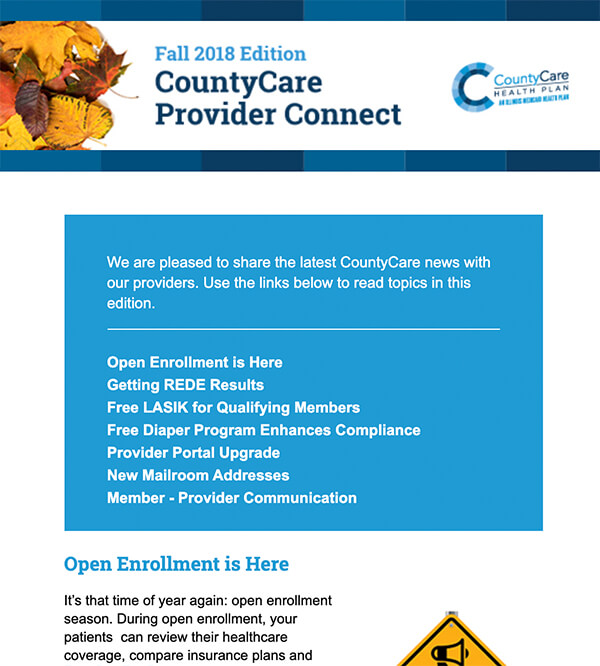
Fall 2018 Newsletter
Open Enrollment is Here, Getting REDE Results, Free LASIK for Qualifying Members, Free Diaper Program Enhances Compliance, Provider Portal Upgrade, New Mailroom Addresses, Member – Provider Communication.
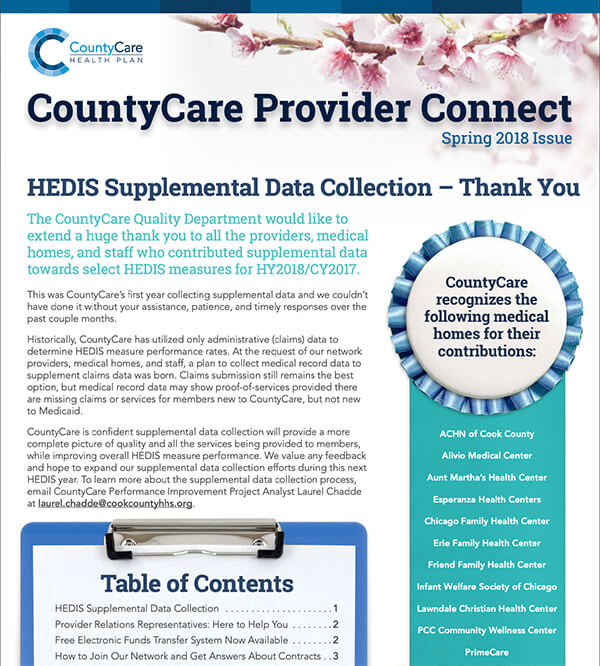
Spring 2018 Newsletter
HEDIS Supplemental Data Collection, Provider Relations Representatives, Free Electronic Funds Transfer, Joining Our Network, Updating Your Information, Provider Portal, Training House Calls, Reminders.
